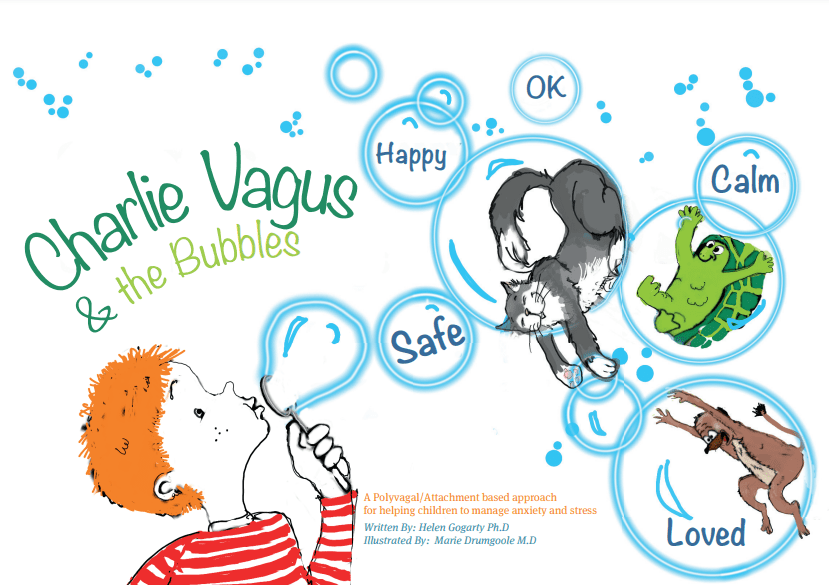Charlie Vagus & the Bubbles
This book has been written for children, their parents, teachers, counsellors and therapists. Its aim is to help children to understand and befriend their own nervous systems, so as to better manage the normal stresses of life. It is based on Attachment and Polyvagal theory. The attachment behavioural system motivates infants to seek proximity to parents at times of stress in order to be soothed and comforted. Through repeated soothing interactions with parents, children gradually learn to regulate and manage their own stress-responses. The capacity to maintain a state of emotional calm can be difficult in the modern world. Depending on their attachment profile, children who are stressed tend to become overwhelmed by emotion or so frightened by it that they become silent and withdrawn. This book describes the three basic attachment patterns, secure, anxious and avoidant in a simple way, using animal characters.
The inspiration for the book came from watching children’s use of symbols in Sandplay. Animals are symbolic of both emotions and instincts. Secure attachment is often represented by a domestic animal, the cat ( Coolio) who is very familiar to most children and who displays both a balance of dependence and independence and an individual sense of self. Meerkats (Milo ) are often used by children who are anxious and prone to bouts of anger, while turtles and tortoises (Terry) are used more frequently by children who are prone to using avoidance and dissociation as stress responses. The more rational thinking part of the brain is Clever Charlie who has an integrating and supporting role.
The Vagus Nerve, which connects body and brain, is described symbolically as a roadway. This conveys the idea that emotions and sensations, which are often experienced by children in the tummy and heart areas of the body, can be moved upwards towards verbal expression and consciousness.
Although this book utilises story as a means of reaching children emotionally, it is not actually written as a Storybook. Therefore, it is not necessary to read the entire text to the child. Younger children respond much better to image and for children under the age of 6, it may be helpful just to talk about the images and ask the child which animal reminds them of how they feel and react when they are worried or upset. For children aged 6-11, especially those who tend to become highly aroused or dissociated when stressed, reading the full text can be very helpful. It enables them to understand that they are not different from other people and that, with help and support, they can begin to change their inner landscape. Teenagers are often very verbal and descriptive and may use the book, not just to understand themselves, but also their peers. Similarly, adults may find concepts that are helpful in terms of managing stress.
€15.00
Seller Bio
Sold by: Dr Helen Gogarty / Dr Marie DrumgooleReviews (1)
1 review for Charlie Vagus & the Bubbles
Add a review

€15.00











Sinéad O’Donnell –
As a foster carer I have found this book to be an excellent resource. The use of the characters to represent the different types of attachment styles is extremely clever & has given me the skills as a carer to identify behaviours in the children I care for presently. The book is very helpful for children to understand their feelings & emotions.